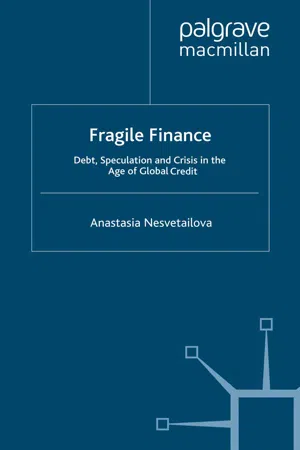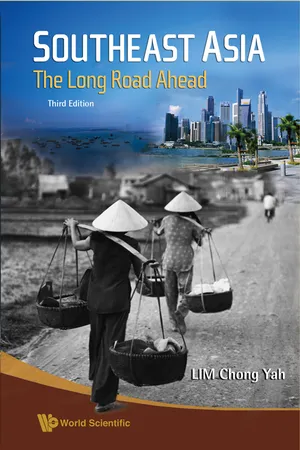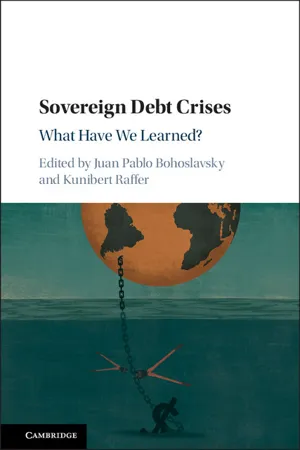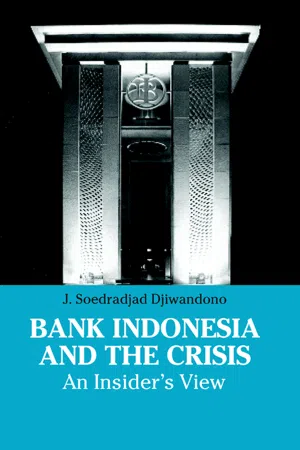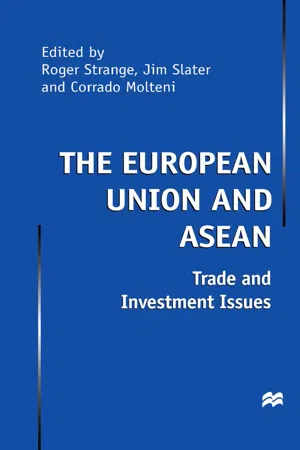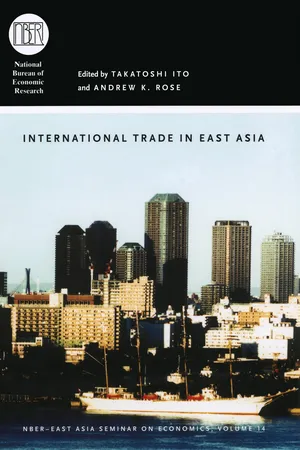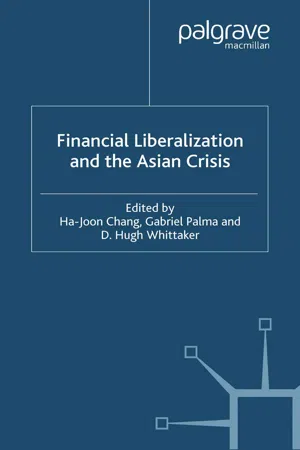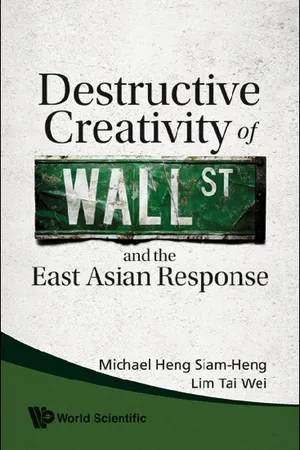Economics
1997 Asian Financial Crisis
The 1997 Asian Financial Crisis was a period of severe economic downturn that affected many Asian countries, including Thailand, South Korea, and Indonesia. It was triggered by a combination of factors such as currency devaluations, excessive foreign borrowing, and financial sector weaknesses. The crisis led to widespread economic and social turmoil, and its effects were felt globally.
Written by Perlego with AI-assistance
Related key terms
1 of 5
12 Key excerpts on "1997 Asian Financial Crisis"
- eBook - PDF
Fragile Finance
Debt, Speculation and Crisis in the Age of Global Credit
- A. Nesvetailova(Author)
- 2007(Publication Date)
- Palgrave Macmillan(Publisher)
6 1 The East Asian Crisis: A Minskyan View There is no shortage of explanations for the series of crises that engulfed East Asia in 1997–1998. While there is no easy way to group up the various interpretations of what is now widely referred to as the ‘Asian financial crisis (AFC)’, three theories stand out. To many mainstream economists, the crisis represented a typical ‘twin’ financial crash, a dangerous cocktail of information asymmetries, financial market failures and, crucially, inept government interfer- ence in the workings of the markets. The Asian model of state dirigisme has proved deficient, prone to inherent cronyism and cor- ruption. In essence therefore, the Asian financial crisis of 1997–1998 was a crisis, as a World Bank report concludes, of crony capitalism: [t]he interaction of these institutional weaknesses with interna- tional capital markets imperfections, and the use of inconsistent macroeconomic policies to manage surging capital inflows gener- ated crucial vulnerabilities that laid the groundwork for the sub- sequent financial crises – and ensured that their consequences would be severe (World Bank 1998/99: 57). On the opposite side of the analytical spectrum, heterodox eco- nomists trace the causes of the 1997/8 Asian collapse to un- predictable and unstable behaviour of the international financial markets. In these interpretations, the crisis contagion, regionally 85 1 I am indebted to Virot Ali for his research help and expertise on East Asia. and internationally, is the result of the speculative attacks on the region’s currencies and herd-like behaviour of foreign investors, most notably banks and hedge funds (Radelet and Sachs 1998; King 2001). Finally, according to many radical critics, the crisis was rooted in the inner dynamics of the capitalist system itself: both in the East Asian national structures of accumulation, and in the trans- formations in the global market (Tabb 1998). - eBook - PDF
Crisis and Restructuring in East Asia
The Case of the Korean Chaebol and the Automotive Industry
- S. Jeong(Author)
- 2004(Publication Date)
- Palgrave Macmillan(Publisher)
As all holders of the countries’ currencies tried to sell, the value of the currencies dropped rapidly. Currency speculators also attacked the Hong Kong dollar and the Taiwanese dollar. 15 The crisis grew from a ‘Southeast Asian’ crisis to an ‘East Asian crisis’ as the ‘contagion effect’ acquired momentum. Between July and December of 1997, European, Japanese and US bankers demanded full repayment of short-term loans from their Asian clients as the loans became due (although they had been lent on the implicit understanding that they would roll over indefinitely). The panicked bankers had no interest in an irrational result of their (indi- vidually rational) market behaviours; they only wanted to escape from the economies as soon as possible. Consequently, without enough foreign reserves, the governments of Thailand, Indonesia and Korea had no option but to turn to the IMF. The Asian financial crisis broke out. Table 2.2 shows that the picture of capital flow changed sharply in 1997 as private capital fled from the five crisis countries. The net private capital inflow (bank lending, portfolio investment, FDI, etc.) to Asia fell from US$110 billion in 1996 to just under US$14 billion in 1997. Bank lending and portfolio investment to Asia became negative in 1997 for the first time since 1990. In the five crisis-hit countries, the net private capital inflow fell to minus US$11 billion in 1997. The sharp reversal of 38 Crisis and Restructing in East Asia bank lending and credits was the major contributor to this capital flight (see ‘Others’ in Table 2.2 and also Ito (2000)). Table 2.3 shows the capital outflow from the five crisis countries more clearly. - eBook - PDF
Southeast Asia
The Long Road Ahead
- Chong Yah Lim(Author)
- 2009(Publication Date)
- WSPC(Publisher)
338 Chapter 12 The Asian Financial Crisis Lenin was right. There is no subtler, no surer means of overturning the existing basis of society than to debauch the currency. John Maynard Keynes, The Economic Consequences of Peace Objectives ■/ Trace the course of the crisis and its subsequent recovery. •/ Provide explanation for the crisis. ■/ Highlight the counter-measures undertaken by the various crisis-hit countries. •/ Summarise the lessons learnt from the crisis. Introduction I t has been some years since the eruption of the infamous Asian financial crisis (1997—1998). The crisis took many people by surprise. From the 1960s, many countries in East Asia had been enjoying double-digit growth, a rate that was unmatched by other countries or regions, including those of all the developed countries. The remarkable economic performances were termed as the East Asian Miracle by the World Bank (1993). However, dreams turned into nightmares when the Asian economic tsunami started in Thailand in mid-1997 and spread quickly to the other countries in the region through a process called negative circular cumulative causation. 12. The Asian Financial Crisis ■ 339 Stock markets tumbled to their all-time lows. Exchange rates were a mere fraction of their pre-crisis values, and banks were overloaded with non-performing loans. Surprisingly, the recovery of the East Asian econ-omies was equally speedy. By the second half of 1999, nearly all the crisis-hit countries had exhibited positive GDP growth rates. We may thus consider this phenomenon as a V-shaped recovery process. However, Table 12.6 shows that in US dollar terms, the per capita income of capital-control economies in Southeast Asia fared much better when 1996 was compared with 2004. Several interesting developments of the Asian financial crisis were observed. Numerous explanations had been put forward to account for the crisis. - eBook - PDF
Governing Risk
The IMF and Global Financial Crises
- M. Moschella(Author)
- 2010(Publication Date)
- Palgrave Macmillan(Publisher)
In this uncertain environment, both domestic and inter- national investors rapidly abandoned the country. On 17 November, The Asian Crisis: Questioning the Consensus 99 authorities abandoned the defense of the currency. The won depreci- ated by more than 50 percent in just five weeks, hitting a low of 55 percent on 23 December. As IMF staff put it in their International Capital Market Report (1998a, p. 2), ‘the extreme turbulence in emerging market currencies during the Asian crisis has been virtually without precedent. When these curren- cies reached their low points in January 1998, the Indonesian rupiah had fallen (relative to its July 1997 level) by 81 percent, the Malaysian ringgit by 46 percent, and the Thai baht by 55 percent.’ With exchange rates plummeting across the region, high interest rates pushed the five most affected countries into deep recession. In 1998, GDP fell by 14 percent in Indonesia and by an average of more than 7 percent in Malaysia, South Korea, Thailand, and the Philippines (Brealy, 1999, p. 286). The Asian Development Bank calculates that the post-crisis average growth rates ‘have slipped by an average 2.5 [percentage points] in the five countries that were most directly affected.’ 167 The (short-term) response to the crisis Asked about where the next Mexican-style crisis would have taken place, Camdessus (1996d) thus replied, ‘I don’t know, but I suspect it will begin with a banking crisis. And even if such a crisis does not start in the banking sector, it will almost certainly be worsened by a bank- ing crisis.’ This prescient remark captures one of the main problems that contributed to the depth and breadth of the Asian crisis. While current account deficits and pegged exchange rates are important fac- tors to account for the problems that some countries initially faced, weaknesses in the domestic financial sector are crucial to account for the severity of the crisis and its scale. - eBook - PDF
Sovereign Debt Crises
What Have We Learned?
- Juan Pablo Bohoslavsky, Kunibert Raffer(Authors)
- 2017(Publication Date)
- Cambridge University Press(Publisher)
i. introduction The widespread economic distress from the Asian currency and financial crisis triggered by the devaluation of the Thai baht on 2 July 1997 shook the 123 foundations of global economic governance. But these foundations, and the dominant political interests buttressing them, stood firm enough to withstand the intense reform proposals the grave crisis generated. At the start of the crisis, few observers expected the economic debacle and political upheaval that engulfed Indonesia in 1997–98. When it became the turn of the eurozone countries to experience the same rigors in the wake of the 2007–08 North Atlantic economic crisis, many lessons from the Indonesian experience could have been applied to avoid or mitigate European distress. Indonesia’s experi- ence was the rehearsal for many of the events and policy choices in the eurozone crisis, taking the sad song of Indonesia’s experience and making it better – by making it sadder still. This chapter presents an analysis of Indonesia’s 1997–98 economic crisis. Because the Indonesian and the East Asian crises elicited numerous accounts, including by this author, 1 this analysis will be an interpretation-with-hindsight of those studies. The axis of the debate sparked by the Indonesian (and the East Asian) crisis has revolved around whether its causes and policy solutions should be assigned to the domestic sphere or to international institutions and policies. With hindsight, both arenas played a key role in the crisis, and it is quite important to accurately define these roles – and how they impelled or interacted with the other sphere. With hindsight it is, for example, possible to say that domestic lessons from the Indonesian crisis were ignored in the practice of financial liberalization in the United States and Europe in the lead-up to the subprime crisis of 2007–08 and the ensuing financial adversities in European credit markets. - eBook - PDF
Bank Indonesia and the Crisis
An Insider's View
- J. Soedradjad Djiwandono(Author)
- 2005(Publication Date)
- ISEAS Publishing(Publisher)
I depicted what seemed to be happening in July 1997 as follows, The rapid downgrading of the region’s sovereign credit ratings by international rating agencies fuelled the shift in market sentiment, triggering panic selling of foreign-owned local assets. In the media, the term ‘Asian miracle’ disappeared suddenly, to be replaced by ‘Asian crisis’ or ‘Asian meltdown’. But the most telling sign was the Institute of International Finance’s publication on capital flows for Thailand, Malaysia, Indonesia, the Philippines and South Korea. The estimates showed a reversal in flows of capital of US$105 billion in these five countries in a single year, from inflows of US$93 billion in 1996 to outflows of US$12 billion in 1997. For Indonesia alone, the reversed capital flow was estimated at US$22 billion, from inflows of US$10 billion to outflows of US$12 billion. This was indeed a financial panic in the Keynesian tradition, as explained by Kindleberger (Djiwandono 2000, p. 49). What happened then in ASEAN economies was clearly a contagion. A shift of market sentiment triggered panic selling of local currency- denominated assets for dollars. It started from market reaction of foreign hedge funds and corporations selling their local currency-denominated assets for dollars. This was immediately followed by “flights to safety” from domestic corporations and individuals with money. However, it is also true that the external shock itself need not have caused crisis of the magnitude that these countries suffered, if their domestic economic, social and political structures had been robust. When Indonesia’s currency market shook, the national economy that was ridden with structural problems wobbled, and the shock rapidly transformed itself into crisis. In turn, the economic crisis induced social and political crises due to the fact that they were already suffering from structural problems. - eBook - PDF
- Masayoshi Tsurumi(Author)
- 2019(Publication Date)
- Taylor & Francis(Publisher)
The last section is conclusion in this chapter. The Liquidity Crisis in Asia Characteristics of Modem Financial Crises The Asian financial crisis was the most serious in recent history in terms of its depth and regional extent. The European currency crisis in 1992 and the Mexican crisis in 1994 may have been immature precedents. Some have called it “a 21st century type” financial crisis. What were the new phenomena in the recent modem financial crisis? The remarkable characteristics were that it was: (1) a compound crisis, (2) a regional crisis, (3) a liquidity crisis, and (4) a private capital-driven crisis. The first conspicuous feature of the Asian financial crisis is that it was not a simple phenomenon but a combined one: a currency crisis, an asset deflation, a banking crisis, and an economic crisis. The first feature, the currency crisis, involved a sudden fall in the exchange rates to the US dollar, and a critical shortage of foreign reserves. The Asian currencies, from the Thai baht to the Indonesia rupiah to the Korean won, fell sharply one after another, to less than half of their value in the pre-crisis six months. Interestingly enough, this currency crisis was accompanied by sharp slumps in the stock markets. Asset deflations in stock and real-estate markets occurred before or after an outbreak of the currency crisis in many of the Asian economies. The slumps in foreign exchange markets were accompanied not only by asset deflation but also by the banking crisis. Many banks suffered from the liquidity crisis due to the sudden increase of Introduction: Financial Crisis and System Reform in Asia 3 non-performing loans and large amounts of deposits withdrawn. While the banking crisis in Thailand, Korea, and Japan occurred before the outbreak of the currency crisis, the banking crisis followed the currency crisis in Malaysia and Indonesia. - eBook - PDF
The European Union and Asean
Trade and Investment Issues
- NA NA(Author)
- 2016(Publication Date)
- Palgrave Macmillan(Publisher)
Section II The Asian Financial Crisis 115 5 Financial Upheaval in the ASEAN Countries: a European Perspective Françoise Nicolas INTRODUCTION After more than a decade of almost uninterrupted strong economic growth, the dynamic ASEAN countries went through a period of heavy financial turbulence from the early summer of 1997. After the European Union (EU) in 1992-93 and Latin America in 1994-95, Southeast Asia was the third region to be hit by a major exchange rate crisis since the beginning of the 1990s. Lessons from the two previous crises may shed light on the mechanisms underlying the most recent developments, even though some features are undoubtedly specific to East Asia thus calling for entirely new analytical approaches. Moreover, because ASEAN countries have been a major engine of growth in the recent past, it appears legitimate to try to assess how the slowdown in economic activity in this region will impact on other regions of the world, in particular on the European Union whose economic recovery in the latter part of the decade was largely export- driven. The purpose of this chapter is twofold. First, it tries to provide an explanation to the contagion of the financial turbulence throughout Southeast Asia, with particular reference to the European Monetary System (EMS) crisis of 1992-93. Second, the chapter examines the various possible implications of the Asian financial and exchange rate crisis for the performance of individual EU economies as well as for the working of the European Union as an institution. It closes with a conclusion on the scope of future economic cooperation between the European Union and East Asia. 117 118 The European Union and ASEAN THEORETICAL CONSIDERATIONS One of the leading explanations advanced for almost all exchange rate crises is that the real exchange rate was previously overvalued. As a result, a nominal devaluation occurs to solve the real over- valuation of the currency. - eBook - PDF
Fighting Financial Fires
An IMF Insider Account
- Onno de Beaufort Wijnholds(Author)
- 2011(Publication Date)
- Palgrave Macmillan(Publisher)
The huge capital inflows received by a number of Asian countries, from those seeking profitable investment opportunities in these fast-growing econo- mies, were also highlighted from time to time as a risk factor, as short-term and portfolio capital (equities and bonds) could be subject to sudden reversal. However, these warnings were of such a general nature that they were largely ignored. While the Mexican crisis was not universally seen as a threat to the interna- tional financial system, the East Asian crisis came to be recognized around the globe as a very dangerous firestorm that could cause first-degree burns among banks and other financial players. The problems first came to the surface in From Miracle to Panic and Back 27 the early summer of 1997, when the currencies of Thailand and the Philippines faced strong downward pressure as capital fled these countries. Other Asian countries’ currencies subsequently came under attack, especially the Malaysian ringgit, the Indonesian rupiah and the Hong Kong dollar. What made the crisis especially acute was that in the fall of 1997, while the stresses in those coun- tries that had been previously targeted were mostly still ongoing, Korea was infected by the stampede of capital heading for the exit. Korea’s economy had grown spectacularly in previous years and had become the eleventh largest in the world, implying that its collapse would have widespread repercussions. Moreover, in a climate of great nervousness in international financial markets, the process of contagion became virulent. Countries such as Brazil, Russia (which was already borrowing from the IMF), Ukraine, South Africa, Turkey, and some smaller emerging market borrowers such as Hungary and Ecuador were also experiencing the fallout of the unrest caused by the pullout of investors from East Asia. Doubts were also expressed as to whether China would be able to withstand the pressure. - eBook - PDF
- Takatoshi Ito, Andrew K. Rose, Takatoshi Ito, Andrew K. Rose(Authors)
- 2007(Publication Date)
- University of Chicago Press(Publisher)
253 8.1 Introduction The world su ff ered three major financial crises in the last ten years, namely, the European Monetary System (EMS) crisis in 1992–1993, the Mexican crisis in 1994–1995 (which spread to a number of South Ameri-can countries), and the Asian crisis in 1997–1998. Economists usually be-lieve these crises were the results of weak economic fundamentals, for ex-amples, declining foreign reserve, increasing foreign debt, capital account and current account deficits, fiscal deficit, and so on. Obviously, a current account deficit can be a very important factor be-cause, other things being equal, it increases foreign debt, decreases foreign reserves, and weakens confidence in the exchange rate of the domestic currency. Almost all countries that su ff ered financial crises had faced ris-ing current account deficits before the crises occurred. So such deficits are widely regarded as an important factor of financial crises. International trade links play an important role in the so-called conta-gious e ff ect, that is, a crisis in one country causes a new crisis in another country with relatively good fundamentals. Glick and Rose (1999) pro-vided some analysis of the relationship between trade and contagion, while Zihui Ma is lecturer of international economics at Renmin University of China. Leon-ard K. Cheng is professor and department head of economics at the Hong Kong University of Science and Technology. We thank Chin Hee Hahn, Kozo Kiyota, Andrew Rose and other seminar participants at the Fourteenth NBER-East Asia Seminar on Economics for helpful comments and sugges-tions. The work described in this paper was substantially supported by a grant from the Re-search Grant Council of the Hong Kong Special Administrative Region, China (Project no. HKUST6212/00H). 8 The E ff ects of Financial Crises on International Trade Zihui Ma and Leonard K. Cheng - H. Chang, G. Palma, D. Whittaker, H. Chang, G. Palma, D. Whittaker(Authors)
- 2001(Publication Date)
- Palgrave Macmillan(Publisher)
14 The Economic Impact of the Asian Crisis on India and China A. S. Bhalla and D. M. Nachane Introduction Ever since the outbreak of the South-east Asian financial crisis, specula- tion has been rife about the likelihood of the ‘contagion’ spreading, and the extent of its possible spread. Policy-makers in different coun- tries have also been preoccupied with examining what measures could be taken to forestall a similar fate befalling their respective economies. This chapter addresses these issues with respect to the two Asian giants, India and China. The two countries share certain common features such as size and geographical proximity to the crisis region, but differ widely in other respects. Apart from the well-known differences in their political systems and the role of markets, at least two other diver- gent features stand out. Firstly, attitudes to foreign investment in the recent past have differed sharply. Whereas India has been extremely cautious about foreign direct investment (FDI) but relatively open to foreign portfolio investment (FPI), the opposite seems to have been the case in China. Secondly, the Indian banking and financial system has evolved to a stage of maturity and sophistication that does not seem evident in China. The aim of this chapter is to assess the vulnerability of these two countries to the Crisis. It is now generally agreed that the South-east Asian collapse was the logical culmination of an inappropriate financial liberalization strategy, with volatile capital flows acting as a triggering factor (see Radelet and Sachs, 1998). Thus a careful scrutiny of the domestic financial system and the international capital account in both countries is a first step in our analysis. But there is also the pos- sibility of a transmission of the Crisis (from South-east Asia to either India or China) via the following two channels: (i) the direct and 237 indirect impact on exports due to the Crisis, and (ii) the impact on the inflows of FDI and FPI.- Michael Siam-heng Heng, Tai Wei Lim(Authors)
- 2009(Publication Date)
- World Scientific(Publisher)
Feldstein, M (1991). The risk of economic crisis: An introduction, in Feldstein, M (ed.), The Risk of Economic Crisis . Chicago: University of Chicago Press. Finer, SE (1997). The History of Government, Volumes 2–3. Oxford: Oxford University Press. Hill, B (1996). Japan Behind The Lines (Australia: Sceptre). Ichimura, S (1998). Political Economy of Japan and Asian Development (Singapore: ISEAS). Ichimura, S (1998). Political Economy of Japan and Asian Development . Keynes, JM (1936). The General Theory of Employment, Interest and Money. London: MacMillan. Khor, M (2000). Globalization and the South (Malaysia: TWN). Krugman, P (2009). The Return of Depression Economics and the Crisis of 2008 . New York: Norton. Lopez, RS (1976). The Commercial Revolution of the Middle Ages, 950–1350. Cambridge: Cambridge University Press. Luttwak, E (1999). Turbo Capitalism . NY: HarpersPerennial. March, J (1994). A Primer on Decision Making . New York: The Free Press. Pollin, R and G Dymski (1994). The costs and benefits of finan-cial instability: Big government capitalism and the Minsky Paradox. Roberts, JM (1996). A History of Europe. Oxford: Helicon. Rohwer, J (1996). Asia Rising , NY: Simon & Schuster. Rutterman, PJ (1995). Financial fragility and supervision: a dis-cussion, in Benink, HA (ed.), Coping with Financial Fragility and Systemic Risk , Boston: Kluwer Academic Publishers, p. 293. Schumpeter, J (1934). The Theory of Economic Development . Boston: Harvard University Press. Stiglitz, J (2004). Roaring Nineties. Penguin Books. 240 Destructive Creativity of Wall Street and the East Asian Response Articles/Speeches ASEAN Secretariat (2005). “Initiative for ASEAN Integration (IAI) Work Plan for the CLMV Countries Progress Report as at 15 May 2005” in the ASEAN Secretariat website, www. aseansec.org/pdf/IAI-Article.pdf. Last accessed 7 October 2008.
Index pages curate the most relevant extracts from our library of academic textbooks. They’ve been created using an in-house natural language model (NLM), each adding context and meaning to key research topics.
